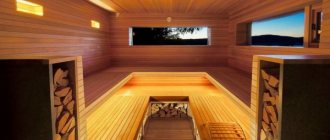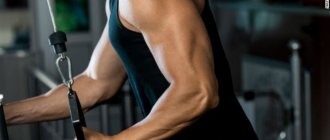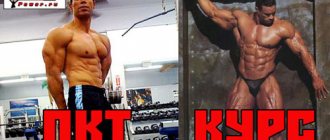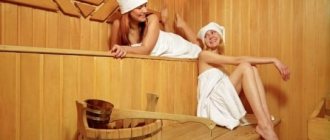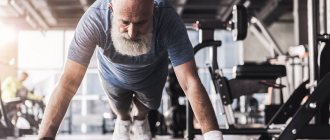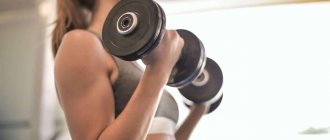Bath and sauna after training: pros and cons[edit | edit code]
Most articles on the Internet and in the literature describe the effects of a post-workout sauna on the body as positive, but this opinion is not always justified. We can highlight the positive and negative factors that a sauna has on a bodybuilder’s body after a workout.
Positive sides
- Mental satisfaction
- A sauna after a workout and at any other time causes a hardening effect, since high temperature is stress to which the body is forced to develop an adaptation.
- Improving microcirculation and removing lactic acid from muscles that accumulates during exercise
- Reducing the risks of sudden cardiac death, fatal coronary artery disease (CHD), and fatal cardiovascular diseases.[1]
Controversial and negative aspects
- As already mentioned, in the sauna the athlete is exposed to additional stress, and therefore catabolic hormones that destroy muscles are intensively produced. Therefore, the advisability of going to a sauna or bathhouse after a workout is very doubtful.
- Fat burning - high temperature slightly accelerates metabolism, so the main loss of body weight occurs not due to fat, but due to the removal of fluid. Thus, using a sauna after a workout can lead to dehydration, which will only slow down your recovery.
- Elimination of electrolytes
- Strength and cardio training places significant stress on the heart. In the sauna and bathhouse, due to the dilation of blood vessels, the heart begins to contract much more intensely. All this together can cause heart overload.
- Cleansing is a pseudoscientific concept that is denied by modern medicine. Removal of toxins, etc. Absolutely unfounded and unproven. The maximum you will get is a placebo effect and hardening.
- A sauna after training creates an obstacle to normal nutrition. After exercise, you need to eat a hearty meal within 1-2 hours to replenish the nutrient deficiency and start anabolic processes in the muscles. Obviously, normal eating for most bodybuilders is only possible at home.
Conclusion:
It is better to take a sauna and bath on rest days, while after training it is preferable to take a shower or a warm bath.
Background
Playing sports and a healthy lifestyle are not a newfangled trend, as many people think. Even in ancient Rome, the cult of a healthy body, as well as a steam bath, was revered. Not only did the Romans engage in sports, but there were thermal baths everywhere - analogues of modern saunas. The most popular types at that time were strength exercises, from which athletics, boxing and wrestling, known today, were formed.
In addition to their love of sports, the ancient Romans also paid a lot of attention to their health and cleanliness of the body. There were thermal baths everywhere, and not only because the Romans considered it necessary to keep the body clean - you could always heat the water and wash yourself.
After grueling training, the citizens of Ancient Rome went to the baths not only to wash themselves, but also to relax, restore blood circulation in tired muscles, and simply chat about politics, culture and life in general. Such a concept as a sauna after the gym would be a completely natural phenomenon for them.
During the USSR, there was also a cult of physical education and sports, but at that time there were no bathhouses at sports complexes. Athletes were limited to taking a shower after training. At the same time, they were considered one of the best in the world. Therefore, it’s worth figuring out what a sauna after the gym is – is it good or bad? And how to properly visit the sauna so as not to harm your health.
Baths after training[edit | edit code]
Source: “Sports Medicine”
Author:
Ed. S.P. Mironova, 2013
Currently, there are Russian, Roman, Turkish (Arab), Irish and Finnish baths.
Russian bath
characterized by the fact that its space is filled with saturated water vapor, forming fog, with a temperature in the range of 40-45 °C (maximum 50 °C). The steam room is equipped with benches located at different heights, the choice of which depends on individual heat tolerance. Cooling is carried out in various ways: water, fresh air, snow.
Roman bath
heated by dry hot air. Its temperature in a warm room (tepidarium) reaches 40-45 °C, and in a laconicum (caldarium) - 60-70 °C. Hot air is supplied to the floor or through holes in the walls. Both rooms are equipped with wooden benches located at different heights. Cooling is carried out in pools with different water temperatures: in the alveus, which is equipped with steps along the perimeter, about 35 °C, in the piscina - about 12 °C.
Turkish bath
has rooms with air temperatures of 50 and 40 °C, and air humidity is regulated by heating water in boilers. Cooling is carried out in a special room by pouring water with a gradually decreasing temperature or while staying in a room at room temperature.
Irish baths
spread in medieval Europe thanks to the efforts of the Irish doctor Barter. This is a bath with low saturation of water vapor without the formation of fog, with a temperature in the steam room of about 50-55 °C. Cooling is carried out using a shower or dousing. By now, these baths have practically disappeared.
Finnish bath (sauna)
heated by hot air with temperatures reaching 100 °C and low relative humidity. The sauna is equipped with stepped benches at different heights, which achieves a temperature difference from 65 to 90 °C. Before finishing your stay in the steam room, the skin is quilted with brooms or other means to provide mechanical irritation. Cooling is done in air or water.
The modes of taking heat-air baths are discussed in table. 1-3.
Table 1. Regime of the first intake of heat-air baths
(total procedure duration 1.0-1.5 hours)
| Periods of taking the heat-air procedure and elements of its implementation | Place of execution of procedure elements | Ambient temperature and procedure duration |
| Adaptation period | ||
| Warm hygienic shower with soap | Shower room | 37-28 °C. 2-3 min |
| Drying. 1st weigh-in | Rest room | 22-25 °C. 2-3 min |
| Two entries with an interval of 10-15 minutes into the heat chamber | 1st Regiment | 50-60 °C. 5-6 minutes each |
| Rest and intercooling in air | Rest room or outdoor veranda | 22-25 °C. 15-20 min |
| Main warm-up period | ||
| 1st entry into the thermal chamber | 1st Regiment | 50-60 °C. 7-10 min |
| Cooling and outdoor recreation | Recreation room, in the warm season - an open climate area | 22-23 °C 15-20 min |
| 2nd entry into the thermal chamber | 1st Regiment | 50-60 °C. 10-15 min |
| Intermediate air cooling | Recreation room, in warm weather - an open climate area | 20-22 “S. 10-15 min |
| 3rd entry into the thermal chamber | 2nd regiment | No more than 80-80 °C. 5-7 min |
| Intercooling using water and air | Pool | 28-32*S.2-3 min |
| Rest and prism replacement fluids (200-300 ml) | Restroom | 15-20 min |
| 4th entry into the thermal chamber | 1st Regiment | 50-60 °C. 3-5 min |
| Period of perspiration and final cooling | ||
| Cooling off in the pool or shower | 28-32 °C. 2-3 min | |
| Cooling and sweating in the air, taking replacement fluids 150-200 ml). 2nd weigh-in | Restroom | 22-23 °C. 15-20 min |
Table 2. Regime of the second intake of heat-air baths
(total procedure duration 1.5-2.0 hours)
| Periods of taking the heat-air procedure and elements of its implementation | Place of execution of procedure elements | Ambient temperature and procedure duration |
| Adaptation period | ||
| Warm hygienic shower with soap | Shower room | 37-38°C. 3-5 min |
| Drying 1st weighing | Restroom | 22-23 °C 2-3 min |
| 1st entry into the thermal chamber | 1st Regiment | 50-60 °C. 7-15 mim |
| Rest and intercooling in air | Restroom | 22-25°C. 10-15 min |
| Intensive warm-up period | ||
| 2nd entry into the thermal chamber | 2nd regiment | 60-70 °C. 5-10 min |
| Intermediate air cooling. in the pool, under the shower | Restroom | 22-23°C, 10-15 minutes 28-30°C. 2-3 min |
| 3rd entry into the thermal chamber | 2nd regiment | 60-70 °C. 7-10 mime |
| Intermediate air cooling. sweating | Restroom | 22-23 °C. 15-20 min |
| Massage, hydromassage (1.0-1.5 atm) | Massage | 5-8 min |
| Ingestion of cooling and replacement fluids (200-400 ml) | Restroom | |
| 4th final entry into the heat chamber using light beating with a birch or other broom | 3rd regiment | 80-85°C. 7-10 min |
| Final cooling period | ||
| Partial or general hydromassage 1.0-1.5 atm) | Massage or bath for | 10 min |
| self-massage | hydromassage | 7-10 min |
| Cooling off in the pool | 14-18 °C. 1-2 min | |
| Showering in the shower | 26-28 °C. 1-2 min | |
| Air baths | Climatoplate | No more than 5-7 minutes |
| Cooling and sweating in the air, drinking drinks (200-300 MP). 2nd weigh-in | Restroom | 22-25 °C. 20-30 min |
Table 3. Mode three of taking heat-air baths
(total duration of the procedure is at least 2 hours)
| Periods of taking the heat-air procedure and elements of its implementation | Place of execution of procedure elements | Ambient temperature and procedure duration |
| Adaptation period | ||
| Warm hygienic shower with soap | Shower room | 38 °C. 3-5 min |
| Drying 1st weighing | Restroom | 22-23 °C 1-2 min |
| 1st entry into the thermal chamber | 1st Regiment | 50-60 °C. 7-10 min |
| Relaxation and cooling in the air | Restroom | 22-23 °C 10-15 min |
| 2nd entry into the thermal chamber | 1st Regiment | 50-80 °C. 7-10 mime |
| Relaxation and cooling in the air | Restroom | 22-23 °C. 10-15 min |
| Main warm-up period | ||
| 3rd entry into the thermal chamber | 2nd regiment | 60-70 °C. 7-10 min |
| Cooling in water | L/sh. pool | 38-30 °C 2-3 min |
| Outdoor recreation | Restroom | 22-23 °C. 10-15 min |
| 4th entry into thermal chambers/ | 2nd regiment | 60-70 °C. 7-10 min |
| Intermediate air cooling. intense sweating | Restroom | 22-23 °C 15-20 min |
| 5th entry into the thermal chamber | 2nd regiment | 60-70 °C. 7-10 min |
| Intercooling | Shower. pool | 20-16 ”C 2-3 in |
| Rest, sweat | Restroom | 22-23 °C. 10-15 min |
| 6th entry into the heat chamber/ (manual kneading of the skin) | 3rd regiment | 80-85 °C. 5-7 min |
| Intermediate cooling in cold and frosty air or wiping with snow | Open climate area | Up to -10 °C. 2-3 min |
| Hydromassage, cooling in the pool (open water) | Not lower than 10 °C. 1-2 min | |
| Relaxing in the air, drinking drinks (200-300 ml) | Restroom | 22-23 °C 16-20 min |
| 7th visit to the thermal chamber | 3rd regiment | 85-90 °C. 5-7 iii |
| Final cooling period | ||
| Cooling in water or outdoors | Pool Climate site | 16-18 °C 2-3 min -10 °C. 2-3 min |
| Cold shower | Shower room | Not higher than 10°C. 1-2min |
| 2nd weighing, air cooling, rest, drinking drinks 1200-300 mp) | Restroom | 22-23 °C. 20-30 min |
When using baths, the following rules must be strictly observed.
- Immediately after physical activity, the use of baths is contraindicated.
- If you steam in a sauna on the day of physical activity, then the duration of stay is 8-10 minutes, and for those who do not have such work - 10-12 minutes. In cases where physical activity is planned a day or more after the sauna, the optimal length of stay in it is 20-25 minutes. If the microclimatic conditions in the sauna differ from those indicated, then the length of stay in the bath should be changed accordingly. At first, it is enough for beginners to make one visit to the steam room for 4-6 minutes.
- The principles of gradualism and consistency should be strictly adhered to. In all cases of deterioration in health (feeling of excessive heat, difficulty breathing, feeling of weakness, dizziness), you must immediately go to the locker room. Otherwise, heat stroke or other serious problems are possible.
- At the end of the bath procedure, it is useful to take a contrast shower. Alternating warm water with cool water is refreshing and invigorating. Body temperature, activity of the cardiovascular and other body systems remain elevated after the bath. It is advisable to avoid sudden cooling. It is highly undesirable to drink cold drinks or be in a draft immediately after a bath. If possible, you need to relax in a warm room, lie down, wrapped in a sheet, drink a glass of tea with lemon.
- For maximum periods of stay in the sauna, you need to rest for 45-60 minutes, i.e. until the initial level of physiological functions is restored.
- To compensate for dehydration at the intermediate stages of staying in the heat chamber and after the end of the procedure, it is necessary to take mineralized liquid (salted tomato juice, slightly alkaline mineral waters, refreshing drinks, fruit juices, freshly brewed weak tea). The amount of fluid taken should approximately be 50-60% of lost body weight (the difference between the initial and final weighing).
On average, the relative loss of water in a person when taking heat-air baths is 1.8 liters.
Data regarding weight loss, changes in heart rate, respiratory rate, blood pressure and subjective sensations during and after the procedure should be recorded in the procedure book.
PRINCIPLES FOR PROCESSING PERSONAL DATA
23. Processing of personal data is carried out on the basis of the following principles:
1. The processing of personal data is carried out on a legal and fair basis;
2. The processing of personal data is limited to the achievement of specific, pre-defined and legitimate purposes. Processing of personal data that is incompatible with the purposes of collecting personal data is not permitted;
3. It is not allowed to combine databases containing personal data, the processing of which is carried out for purposes incompatible with each other;
4. Only those personal data that meet the purposes of their processing are subject to processing;
5. The content and volume of personal data processed correspond to the stated purposes of processing. The personal data processed is not redundant in relation to the stated purposes of processing;
6. When processing personal data, the accuracy of personal data, their sufficiency, and, if necessary, relevance in relation to the stated purposes of their processing are ensured.
7. The storage of personal data is carried out in a form that makes it possible to identify the subject of personal data no longer than required by the purposes of processing personal data, unless the period for storing personal data is established by federal law, an agreement to which the subject of personal data is a party, beneficiary or guarantor. The processed personal data is subject to destruction or depersonalization upon achievement of the processing goals or in the event of loss of the need to achieve these goals, unless otherwise provided by federal law.
Bath and sauna after training[edit | edit code]
Since ancient times in Russia, the bathhouse has been considered an indispensable means of recovery for people engaged in heavy physical labor. It is not without reason that more than a dozen proverbs are devoted to the topic of baths:
- “The bathhouse soars, the bathhouse rules, the bathhouse will fix everything”
- “Vanya was cured - the bathhouse helped him”
- “Banya is the second mother: she will straighten all the bones, she will straighten everything out”
- “The day you sweat, the day you don’t grow old”
In bodybuilding, a steam bath after training occupies a very important place. First of all, you need to determine which of the existing types of baths to choose for yourself. Many people prefer to take a sauna after training, although in essence there is no difference and it all depends only on your desire.
Types[edit | edit code]
All steam baths can be divided into three main types depending on the temperature and humidity in the steam room:
- dry-air baths: city public sauna-heater, Russian, sand, Finnish sauna (with air temperature from 60 to 120 C and humidity from 5 to 25%);
- wet baths: steam bath, Russian, Finnish sauna (the air temperature in them can be from 50 to 70 * C, and humidity - from 80 to 100%);
- water baths, or Japanese ones.
During intense training, experienced athletes visit the steam room at least 2 times a week. For those who do not strive for high sports results, it is enough to visit the bathhouse once a week.
The Russian and Finnish steam rooms enjoy the greatest success among bodybuilders, but most often these are baths that are a cross between the Russian and Finnish steam rooms.
Differences[edit | edit code]
The purpose and consequence of a conscious visit to any sauna is to carry out a thermotherapy procedure, characterized by a short-term and controlled increase in body temperature. The source of heat in any traditional saunas and baths are stoves of various designs - electric, wood, gas. Fundamentally, such baths differ only in differences in the ratio of the main components that facilitate the transfer of heat from the source (stove) to the human body, such as humidity and temperature. In this regard, it is more correct to use for comparison not “Russian baths” and “Finnish saunas”, but “Turkish baths” (hamams) and “Finnish saunas”. In “Finnish saunas,” the effective transfer of heat from the source (stove) to the human body is ensured by extremely high temperatures and low humidity. In a Turkish bath, heat transfer is carried out, on the contrary, due to high humidity air at a much lower temperature. Moreover, the effects on the human body and the mechanisms of sweating are different in both cases. Russian bathhouse has an unimaginable number of variations ranging from Finnish to Turkish. Fundamentally, only infrared saunas (IR saunas) using the method of direct heating by radiation, which have a number of significant advantages over traditional ones, differ from the above saunas of indirect heating (through an intermediate agent - hot air, water vapor).
Process[edit | edit code]
Before entering the steam room itself, you must perform the following simple steps:
- rinse a birch or oak broom with cold water;
- Place a birch broom in a basin of hot water for a while (10-15 minutes), covering it with a second basin (it is enough to pour cold water over an oak broom).
While the broom is steaming, you need to prepare your body for the “sacred rite” so that the body can more easily adapt to the hot steam. This is especially important for those who have not had much bathing experience until now and have limited themselves to bathing in the shower or bathtub.
To do this, you need to start with a 2-3-minute warm shower (without soap), after which you make the first preliminary entry into the steam room without a broom.
You need to take with you some attributes that are unsightly at first glance, but absolutely necessary in the bathhouse:
- knitted hat;
- mittens (made of cloth or cotton);
- flip-flops (to protect the skin of your feet from the hot floor in the steam room).
So, you visited the bathhouse or sauna after training, after which you should go to the dressing room and rest for 2-4 minutes, after wrapping yourself in a sheet or terry towel to keep warm.
During the time spent in the shower and dressing room, the broom will have time to steam, so after a short rest you can safely move on to the main visit to the steam room (this time with a broom). To do this, shake off drops of water from the broom and put a hat on your head, mittens on your hands, and slippers on your feet, and go to the steam room.
You need to start steaming by stroking your entire body with a broom. To do this, first place the broom on your feet, press it with mittens and hold it in this position for several seconds.
You should not immediately climb onto the highest and hottest shelf: the skin, respiratory and cardiovascular systems are not yet ready for high temperatures. On your first visit to the steam room, you can spend 5-7 minutes without waiting for profuse sweating - this is just a warm-up before the main part of the sauna “training”.
In 2-3 minutes of being on the first shelf, the broom has time to dry (it should not be wet), after which you can climb to the second (middle) shelf and start steaming in a sitting position with your legs stretched out.
At the next stage, you can slowly walk with a broom 2-3 times along the calf muscles to the hips, gluteal muscles, back and neck, and then in the reverse order.
After this, the broom is raised up for a while, placing it in the hottest part of the steam room, thus marking the beginning of the next action, during which the broom is first pressed to the upper part of the body (chest and back), gradually lowering it down to the hips, legs and ankles
Particular attention should be paid to the joints (knee, elbow and shoulder). It is better to ask a friend or neighbor in the steam room to treat your lower back with a broom.
The whole complex is repeated 3-4 times, making light movements with a broom so that the branches only lightly touch the body.
At a very high temperature in the steam room, the movements of the broom should be smooth and leisurely, at a relatively low temperature - vice versa. The duration of the second approach should not exceed 5-8 minutes.
After each entry into the steam room, be sure to take a contrast shower (or plunge into a pool of cold water). To begin with, it is enough to do this 1 time. In the future, you can increase the number of dives up to 2-4 times. After this, you need to rest in the dressing room for 8-12 minutes, again wrapping yourself in a sheet or terry towel.
After this (after 2-3 minutes), it is very useful to drink a cup of hot tea.
Those who want to get rid of excess weight usually make 3 to 6 visits to the steam room. You shouldn’t make more visits, especially for beginners. They wash the body with soap at the very end, after completing all procedures.
Other tips[edit | edit code]
And finally, every athlete has days when he has neither the strength nor the desire to go to the gym. There are several proven ways to regain your fighting spirit and desire to train.
- Radically change your usual workout, perform some new, completely unfamiliar exercise.
- Purchase a one-time membership to another sports club.
- Conduct several training sessions under the guidance of a trainer.
- Watch a good video about bodybuilding.
- Attend a workout with a friend.
- Take a day off and have a good rest.
If an athlete spends too much time training or is too busy at work, then sometimes it would be useful to completely relax and not think about anything or change the type of activity for a while.
Types of sauna
There are a huge number of different water procedures based on warming the body with moist or dry air. They all have common features, and any innovation can rather be considered a modernization of the method of heating the air, but not a new type of bathhouse. Today there are only 5 main types of baths:
- Russian bath. It involves the use of mechanical abrasive action, which accelerates blood throughout the body and expels lactic acid faster.
- Turkish bath - also known as hammam. Involves using a cold pool next to the sauna. Immersion in cold water quickly tones muscles, but limits use for people with weak hearts.
- Dry electric sauna. Dry steam allows you to warm the air to a higher temperature, provoking more intense sweating.
- Finnish sauna. More of a relaxing procedure than a restorative one. The absence of additional factors helps to recover psychologically.
Bath and sauna[edit | edit code]
Source:
“Bodybuilding.
Book trainer" .
Editor:
Oksana Usoltseva
Ed.
: Eksmo 2013
Bath procedures are used not only in everyday life, but also in a sports environment - as a means of restoration and improvement of performance.
Bath procedures associated with increased sweating help remove metabolic products from the body, improve metabolism and reduce pain in joints and muscles after exercise. They dilate blood vessels and lower blood pressure.
A sharp change in temperature strengthens the immune system, allowing you not to miss training due to illness. Increases muscle strength and endurance. The air humidity in the sauna and Russian bath is different. In the sauna, the humidity is lower (10-15%), making the high temperature better tolerated. The peculiarities of the Russian bath are steam, which is pumped up due to the fact that water is supplied to the stove-stove, and the use of brooms.
Here are a few rules to follow in the sauna and steam bath:
- before entering the steam room, take a warm shower;
- do not go upstairs straight away, sit, or rather lie down on the bottom or middle shelf;
- duration of the first approach - 8-12 minutes;
- between visits it is permissible to swim for 40-60 seconds in a pool with cool water (+12...+17 °C) or take a shower;
- Drink more fluids when visiting the sauna and steam bath;
- do not drink alcohol;
- visit the bathhouse or sauna no more than twice a week;
- Don't worry about being overtired.
You can perform self-massage between visits to the steam room.
If in the bathhouse you experience a feeling of heat, heaviness in the head, dizziness, or other undesirable consequences, it is a good idea to consult a doctor.
RIGHTS OF PERSONAL DATA SUBJECTS
38. The subject of personal data has the right:
1. to receive personal data relating to a given subject and information regarding their processing;
2. to clarify, block or destroy his personal data if they are incomplete, outdated, inaccurate, illegally obtained or are not necessary for the stated purpose of processing;
3. to withdraw his consent to the processing of personal data; - to protect their rights and legitimate interests, including compensation for losses and compensation for moral damage in court;
4. to appeal the actions or inaction of the Operator to the authorized body for the protection of the rights of personal data subjects or in court.
5. To exercise their rights and legitimate interests, subjects of personal data have the right to contact the Operator personally or with the help of a representative.
6. The request must contain the information specified in Part 3 of Art. 14 Federal Law “On Personal Data” and should be sent to the address specified in clause 1.5 of the Policy.
